
The Battle of Trafalgar was a naval engagement that took place on 21 October 1805 between the British Royal Navy and the combined fleets of the French and Spanish Navies during the War of the Third Coalition of the Napoleonic Wars (1803–1815).

A ship of the line was a type of naval warship constructed during the Age of Sail from the 17th century to the mid-19th century. The ship of the line was designed for the naval tactic known as the line of battle, which involved the two columns of opposing warships manoeuvering to volley fire with the cannons along their broadsides. In conflicts where opposing ships were both able to fire from their broadsides, the faction with more cannons firing – and therefore more firepower – typically had an advantage.

HMS Bellerophon, known to sailors as the "Billy Ruffian", was a ship of the line of the Royal Navy. A third-rate of 74 guns, she was launched in 1786. Bellerophon served during the French Revolutionary and Napoleonic Wars, mostly on blockades or convoy escort duties. She fought in three fleet actions: the Glorious First of June (1794), the Battle of the Nile (1798) and the Battle of Trafalgar (1805). While the ship was on blockade duty in 1815, Napoleon boarded Bellerophon so he could surrender to the ship's captain, ending 22 years of almost continuous war between Britain and France.

HMS Africa was a 64-gun third-rate ship of the line of the Royal Navy, launched by William Barnard at Barnard's Thames Yard in Deptford on 11 April 1781.

HMS Superb was a 74-gun third-rate ship of the line of the Royal Navy, and the fourth vessel to bear the name. She was launched on 19 March 1798 from Northfleet, and was eventually broken up in 1826. Superb is mostly associated with Richard Goodwin Keats who commanded her as captain from 1801 until his promotion in 1806. Keats famously spent only one night out of the ship during four and a half years out of a home port. She also served as his flagship from early 1808 until she was paid off in 1809.

HMS Neptune was a 98-gun second-rate ship of the line of the Royal Navy. She served on a number of stations during the French Revolutionary and Napoleonic Wars and was present at the Battle of Trafalgar in 1805.
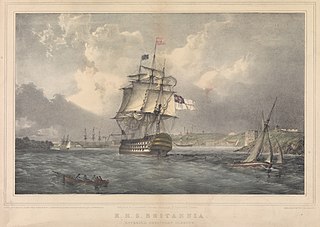
HMS Britannia was a 100-gun first-rate ship of the line of the Royal Navy. The vessel was laid down in 1751 and launched in 1762. Nicknamed Old Ironsides, she served in the American Revolutionary War, the French Revolutionary Wars and the Napoleonic Wars, including at the Battle of Trafalgar in 1805. One of the largest Royal Navy warships of her era, Britannia was one of only three British first-rates present at the battle, alongside HMS Victory and HMS Royal Sovereign. In 1806, the vessel was laid up and eventually converted into a hulk, before being broken up in 1825.
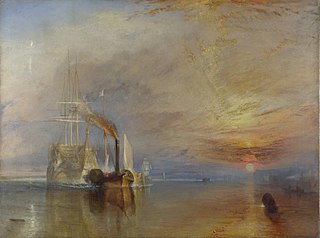
HMS Temeraire was a 98-gun second-rate ship of the line of the United Kingdom's Royal Navy. Launched in 1798, she served during the French Revolutionary and Napoleonic Wars, mostly on blockades or convoy escort duties. She fought only one fleet action, the Battle of Trafalgar, but became so well known for that action and her subsequent depictions in art and literature that she has been remembered as The Fighting Temeraire.
HMS Thunderer was a ship of the line of the Royal Navy, built in 1783. She carried 74-guns, being classified as a third rate. During her service she took part in several prominent naval battles of the French Revolutionary Wars and the Napoleonic Wars; including the Glorious First of June, the Battle of Cape Finisterre and the Battle of Trafalgar.

Neptune was a Bucentaure-class 80-gun ship of the line of the French Navy. Built during the last years of the French Revolutionary Wars she was launched at the beginning of the Napoleonic Wars. Her brief career with the French included several major battles, though she spent the last 12 years of her life under the Spanish flag.

Achille was a Téméraire-class 74-gun French ship of the line built at Rochefort in 1803 after plans by Jacques-Noël Sané.
HMS Achille was a 74-gun third-rate ship of the line of the Royal Navy. She was built by Cleverley Bros., a private shipyard at Gravesend, and launched on 16 April 1798. Her design was based on the lines of the captured French ship Pompée. She was the fourth Royal Navy ship to be named after the Greek hero Achilles in the French style.

HMS Berwick was a 74-gun Elizabeth-class third rate of the Royal Navy, launched at Portsmouth Dockyard on 18 April 1775, to a design by Sir Thomas Slade. She fought the French at the Battle of Ushant (1778) and the Dutch at the Battle of Dogger Bank (1781). The French captured her in the action of 8 March 1795 during the French Revolutionary Wars and she served with them with some success then and at the start of the Napoleonic Wars until the British recaptured her at the Battle of Trafalgar. Berwick sank shortly thereafter in a storm.
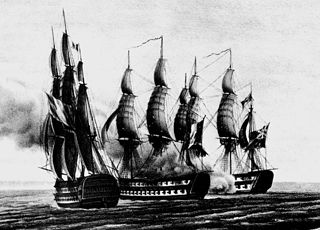
HMS Swiftsure was a 74-gun third rate ship of the line of the British Royal Navy. She spent most of her career serving with the British, except for a brief period when she was captured by the French during the Napoleonic Wars in the action of 24 June 1801. She fought in several of the most famous engagements of the French Revolutionary and Napoleonic Wars, fighting for the British at the Battle of the Nile, and the French at the Battle of Trafalgar.
Vice Admiral Sir Richard Grindall KCB was an officer in the British Royal Navy whose distinguished career during the American War of Independence, the French Revolutionary War and the Napoleonic Wars was highlighted by his presence at the battle of Trafalgar in 1805, Despite being slow and ungainly, his 98-gun ship Prince was instrumental in the final stages of the battle and especially in the chaotic storm which followed, when many of the British fleet would have been lost but for the efforts of Grindall and other captains of largely undamaged ships.
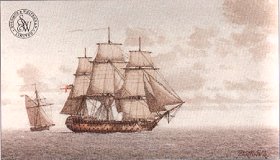
HMS Edgar was a 74-gun third-rate ship of the line of the Royal Navy, that saw service in the American Revolutionary, French Revolutionary and Napoleonic Wars. Launched in 1779, she fought in the battles of Cape St Vincent and Copenhagen, two of the major naval engagements of the wars.

HMS Formidable was a 98-gun second rate man-of-war serving the Royal Navy.
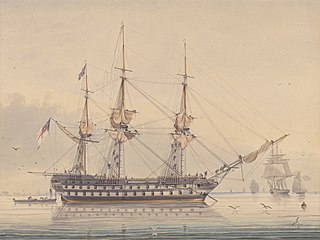
HMS Donegal was launched in 1794 as Barra, a Téméraire class 74-gun ship of the line of the French Navy. She was renamed Pégase in October 1795, and Hoche in December 1797. The British Royal Navy captured her at the Battle of Tory Island on 12 October 1798 and recommissioned her as HMS Donegal.

HMS Expedition was a 70-gun third-rate ship of the line built at Portsmouth Dockyard in 1677/79. She was in active commission during the War of the English Succession participating in the battles of Beachy Head and Barfleur. She was rebuilt in 1699. Again, for the War of Spanish Succession she was in commission for the operation at Cadiz then returned to England where she sat for two years. She was in the Mediterranean for the Battle of Marbella in 1705. She then went to the West Indies and fought in Wager's action off Cartagena in 1708. She was rebuilt in 1709-14 to the 1706 Establishment. She spent her time split between the Baltic and as guard ship at Portsmouth before being broken at Portsmouth in 1736. She was rebuilt in 1736/40 at Deptford Dockyard.

HMS Victory is a 104-gun first-rate wooden sailing ship of the line. With 247 years of service as of 2025, she is the world's oldest naval vessel still in commission. She was ordered for the Royal Navy in 1758, during the Seven Years' War and laid down in 1759. That year saw British victories at Quebec, Minden, Lagos and Quiberon Bay and these may have influenced the choice of name when it was selected in October the following year. In particular, the action in Quiberon Bay had a profound effect on the course of the war; severely weakening the French Navy and shifting its focus away from the sea. There was therefore no urgency to complete the ship and the signing of the Treaty of Paris in February 1763, meant that when Victory was finally floated out in 1765, she was placed in ordinary. Her construction had taken 6,000 trees, 90% of them oak.



















